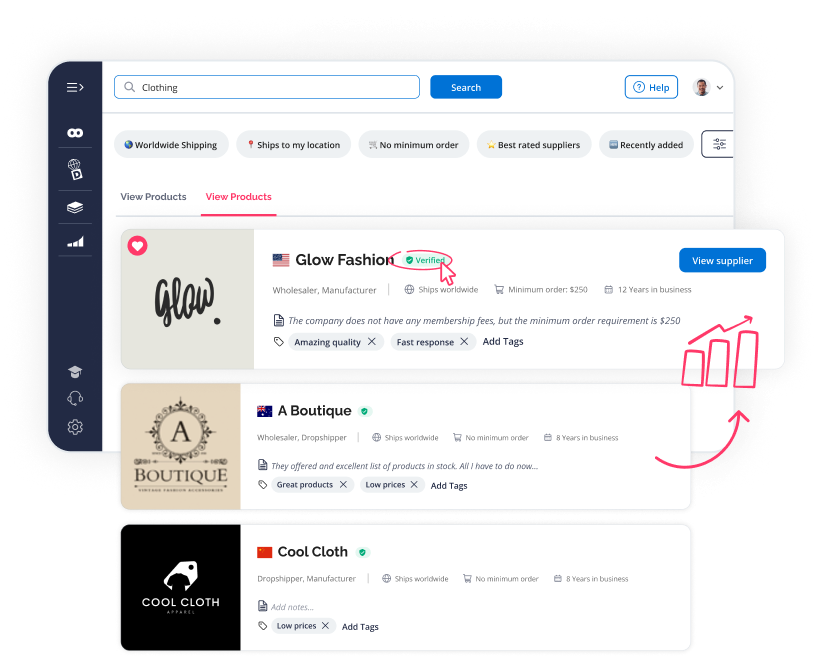Wholesale Coffee Tables for Online Retailers
Coffee tables are not just functional pieces of furniture; they serve as focal points in living spaces, combining style and practicality to enhance the aesthetic and comfort of homes. When sourcing suppliers, look for high-quality materials and diverse designs that cater to various tastes—from minimalist to rustic—while ensuring reliable craftsmanship and competitive pricing. Always request samples and detailed product specifications to ensure they meet your quality standards, and consider trends in the market to stay ahead of consumer demands

Here’s a selection of suppliers waiting for your call
Manufacturer Supplier
 Verified
Verified
 Join to contact this supplier
Join to contact this supplier
 $101 - $500
$101 - $500
 16 Years in SaleHoo
16 Years in SaleHoo
Products stocked
About
Wholesale Supplier
 Verified
Verified
 Join to contact this supplier
Join to contact this supplier
 No Minimum Order
No Minimum Order
 1 Years in SaleHoo
1 Years in SaleHoo
Products stocked
About
Wholesale Supplier
 Verified
Verified
 Join to contact this supplier
Join to contact this supplier
 Ships worldwide
Ships worldwide
 No Minimum Order
No Minimum Order
 6 Years in SaleHoo
6 Years in SaleHoo
Products stocked
About
Wholesale Supplier
 Verified
Verified
 Join to contact this supplier
Join to contact this supplier
 No Minimum Order
No Minimum Order
 1 Years in SaleHoo
1 Years in SaleHoo
Products stocked
About
Dropship Supplier
 Verified
Verified
 Join to contact this supplier
Join to contact this supplier
 No Minimum Order
No Minimum Order
 12 Years in SaleHoo
12 Years in SaleHoo
Products stocked
About
Dropship Supplier
 Verified
Verified
 Join to contact this supplier
Join to contact this supplier
 No Minimum Order
No Minimum Order
 9 Years in SaleHoo
9 Years in SaleHoo
Products stocked
About
Wholesale Supplier
 Verified
Verified
 Join to contact this supplier
Join to contact this supplier
 No Minimum Order
No Minimum Order
 4 Years in SaleHoo
4 Years in SaleHoo
Products stocked
About
Dropship Supplier
 Verified
Verified
 Join to contact this supplier
Join to contact this supplier
 No Minimum Order
No Minimum Order
 10 Years in SaleHoo
10 Years in SaleHoo
Products stocked
About
Wholesale Supplier
 Verified
Verified
 Join to contact this supplier
Join to contact this supplier
 No Minimum Order
No Minimum Order
 1 Years in SaleHoo
1 Years in SaleHoo
Products stocked
About
Wholesale Supplier
 Verified
Verified
 Join to contact this supplier
Join to contact this supplier
 No Minimum Order
No Minimum Order
 14 Years in SaleHoo
14 Years in SaleHoo
Products stocked
About
Other product suppliers available...
Trusted by 137,000+ entrepreneurs worldwide

7-day trial today
suppliers in the USA and internationally.
Frequently Asked Questions
Common materials for coffee tables include solid wood, MDF (Medium Density Fiberboard), metal, and glass. Each material offers distinct advantages in terms of durability, aesthetics, and weight, so consider your target market and design preferences.
Lead times can vary significantly based on the complexity of the design and the supplier's capacity, but it generally ranges from 4 to 12 weeks. Custom designs or large orders may require longer lead times due to extended production and shipping processes.
Yes, certifications such as FSC (Forest Stewardship Council) for wood products and CARB (California Air Resources Board) compliance for VOC emissions in MDF are important. These certifications ensure sustainability and safety, which can be critical for market appeal.
Reputable suppliers should have robust quality control processes that include inspections at various stages of production, from raw materials to finished products. Requesting sample products or third-party testing certifications can also help ensure quality standards are met.
To maintain design originality, conduct thorough research to avoid existing patents or trademarks on similar styles. Collaborating with designers or seeking legal advice can help protect your unique designs and ensure compliance with intellectual property laws.


